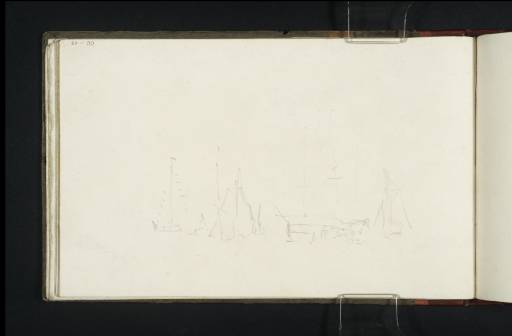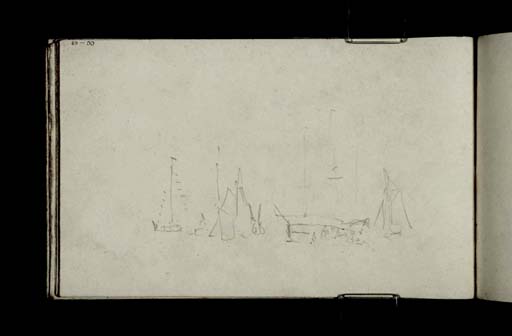Joseph Mallord William Turner The Royal Squadron 1822
Image 1 of 2
Joseph Mallord William Turner,
The Royal Squadron
1822
Joseph Mallord William Turner 1775–1851
Folio 69 Recto:
The Royal Squadron 1822
D17627
Turner Bequest CC 69
Turner Bequest CC 69
Pencil on white wove paper, 114 x 187 mm
Inscribed in red ink by John Ruskin ‘69’ top left inverted
Stamped in black ‘CC 69’ top left inverted
Inscribed in red ink by John Ruskin ‘69’ top left inverted
Stamped in black ‘CC 69’ top left inverted
Accepted by the nation as part of the Turner Bequest 1856
References
1909
A.J. Finberg, A Complete Inventory of the Drawings of the Turner Bequest, London 1909, vol.I, p.612, CC 69, as ‘Shipping.’.
1981
Gerald Finley, Turner and George the Fourth in Edinburgh 1822, exhibition catalogue, Tate Gallery, London 1981, pp.85, [197] reproduced as ‘Shipping’.
One of numerous sketches of the royal squadron at Leith Roads, this sketch, made with the sketchbook inverted, shows a number of vessels, some at anchor and others at sail. Alongside the largest vessel there is a series of jottings that seem to represent a barge and its passengers. This motif could relate to several events witnessed by Turner on the 14 and 15 August 1822.
On the 14th there were a number of visitor’s to George IV’s yacht, the Royal George, the most significant of whom was Sir Walter Scott. Turner made several sketches of the event in this book (see folio 49 verso; D17590) and it was chosen as the first subject of his proposed ‘Royal Progress’ scheme (see King’s Visit to Edinburgh 1822 sketchbook Introduction), and worked up into an oil sketch: The Mission of Sir Walter Scott, circa 1823 (Tate N02879).1 Many private boats were also taken out to Leith Roads that day by people, like Turner, eager to see the royal squadron and to catch a glimpse of the King.2
The other event of interest to Turner that this sketch could depict was the King’s departure from the Royal George in the royal barge. This too was witnessed and sketched by Turner (see folio 5 verso; D17517), and was one of the ‘Royal Progress’ subjects (see King’s Visit to Edinburgh 1822 sketchbook Introduction) that Turner developed as an oil sketch: The King’s Departure from the ‘Royal George’ in the Royal Barge, circa 1823 (Tate N20880).3 Although pages in close proximity to this one in the sketchbook depict the Walter Scott subject (for example folio 68 verso; D17626), there is good reason to suggest that this latter subject is more likely. On the port side of the largest vessel, to the top right of the barge, is what appears to be the launching crane that is depicted on folio 5 verso. That sketch was identified by Gerald Finley as depicting the recently launched royal barge, so the current drawing may show the subject again.
Thomas Ardill
August 2008
How to cite
Thomas Ardill, ‘The Royal Squadron 1822 by Joseph Mallord William Turner’, catalogue entry, August 2008, in David Blayney Brown (ed.), J.M.W. Turner: Sketchbooks, Drawings and Watercolours, Tate Research Publication, December 2012, https://www


